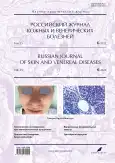Verrucous epidermal nevi: some aspects of pathogenesis and clinical cases
- Authors: Okladnikova E.V.1, Selitskaya O.V.1
-
Affiliations:
- Professor V.F. Voino-Yasenetsky Krasnoyarsk State Medical University
- Issue: Vol 25, No 6 (2022)
- Pages: 17-23
- Section: DERMATO-ONCOLOGY
- URL: https://journals.rcsi.science/1560-9588/article/view/132583
- DOI: https://doi.org/10.17816/dv112571
- ID: 132583
Cite item
Abstract
Verrucous epidermal nevi ― hamartomas of keratinocyte or epidermal appendages, located on the skin or mucous membranes in the form of isolated birthmarks, less often have a linear localization. The pathogenesis of verrucous epidermal nevi has not been fully defined, probably the development of the disease is associated with genetic mutations during embryogenesis and represent a special form of skin mosaicism. Verrucous epidermal nevi are skin pathologies that require attention as potentially dangerous in terms of the development of malignant neoplasms of the skin and due to the possible difficulties in their diagnosis and differential diagnosis.
Analysis of current data on the pathogenesis and differential diagnosis of various forms of verrucous epidermal nevi, presentation of clinical cases of verrucous epidermal nevi.
The article considers two clinical cases of linear verrucous epidermal nevus. Studies of the pathogenesis of WEN have shown the presence of changes in expressed proteins by affected skin cells, such as OGN, NT5C3A, ADD1, OLFML1, DHRS1, CALML5, SAMHD1, SFRP2, SPRR1B and SERPINB13. This may indicate the participation in the development of verrucous epidermal nevi of changes in the p53 signaling pathway, the cellular response to a cytokine stimulus, and disturbances in cell adhesion and differentiation of Th1 and Th2 cells. The presented clinical cases describe linear verrucous epidermal nevus in order to study the diagnosis of the disease, based on the clinical picture. The need for differential diagnosis of various forms of verrucous epidermal nevi is due to their clinical and sometimes histological similarity with other skin formations. Immunohistochemical examination, genetic analysis using sequencing of the affected skin exome, and proteomic analysis of proteins expressed by affected skin cells help to carry out differential diagnosis.
The study of the mechanisms of development of this disease will help not only in differential diagnosis with other skin diseases, but will also allow finding new approaches to its conservative therapy.
Full Text
##article.viewOnOriginalSite##About the authors
Evgeniya V. Okladnikova
Professor V.F. Voino-Yasenetsky Krasnoyarsk State Medical University
Author for correspondence.
Email: farmasis@yandex.ru
ORCID iD: 0000-0002-1909-222X
SPIN-code: 1220-9302
MD, Associate Professor
Russian Federation, KrasnoyarskOlga V. Selitskaya
Professor V.F. Voino-Yasenetsky Krasnoyarsk State Medical University
Email: selickaya@inbox.ru
ORCID iD: 0000-0003-3960-1279
SPIN-code: 1993-5439
MD, Associate Professor
Russian Federation, KrasnoyarskReferences
- Elmas ÖF, Akdeniz N. Dermoscopic aspect of verrucous epidermal nevi: New findings. Turk J Med Sci. 2019;49(3):710–714. doi: 10.3906/sag-1811-27
- Tlish MM, Sycheva NL, Avdienko IN, Faustov LA. Generalized verrucous epidermal nevus: the clinico-morphological diagnostic algorithm. Russian journal of Clinical dermatology and venereology. 2014;12(6):97–101. (In Russ). doi: 10.17116/klinderma2014697-101
- Ocampo-Garza J, Di Chiacchio NG, Haneke E, et al. Verrucous epidermal naevus: A misleading diagnosis for 28 years. J Eur Acad Dermatol Venereol. 2018;32(3):e109–e110. doi: 10.1111/jdv.14597
- Kouzak SS, Mendes MS, Costa IM. Cutaneous mosaicisms: Concepts, patterns and classifications. An Bras Dermatol. 2013;88(4):507–517. doi: 10.1590/abd1806-4841.20132015
- Jackson R. The lines of Blaschko. Br J Dermatol. 1976;96:349–359. doi: 10.1111/j.1365-2133.1976.tb00835.x
- Asch S, Sugarman JL. Epidermal nevus syndromes: New insights into whorls and swirls. Pediatr Dermatol. 2018;35(1):21–29. doi: 10.1111/pde.13273
- Atzmony L, Khan HM, Lim YH, et al. Second-hit, postzygotic PMVK and MVD mutations in linear porokeratosis. JAMA Dermatol. 2019;155(5):548–555. doi: 10.1001/jamadermatol.2019.0016
- Yarak S, Machado TY, Ogawa MM, et al. Squamous cell carcinoma arising in a multiple verrucous epidermal nevus. An Bras Dermatol. 2016;91(5 Suppl 1):166–168. doi: 10.1590/abd1806-4841.20164506
- Atzmony L, Ugwu N, Hamilton C, et al. Inflammatory linear verrucous epidermal nevus (ILVEN) encompasses a spectrum of inflammatory mosaic disorders. Pediatr Dermatol. 2022;39(6):903–907. doi: 10.1111/pde.15094
- Riachi M, Polubothu S, Stadnik P, et al. Molecular genetic dissection of inflammatory linear verrucous epidermal naevus leads to successful targeted therapy. J Invest Dermatol. 2021;141(12):2979–2983.e1. doi: 10.1016/j.jid.2021.02.765
- Yuan T, Lu XH, Tang B Mr, et al. Differences in clinical characteristics and lesion proteomics between inflammatory linear verrucous epidermal nevus and local verrucous epidermal nevus. J Proteomics. 2022;260:104554. doi: 10.1016/j.jprot.2022.104554
- Tseng HW, Liao JB, Wei YA. Adult-onset inflammatory linear verrucous epidermal nevus: Immunohistochemical studies and review of the literature. J Cutan Pathol. 2021;48(1):140–146. doi: 10.1111/cup.13881
- Yuan T, Cai ML, Sheng YM, et al. Differentially expressed proteins identified by TMT proteomics analysis in children with verrucous epidermal naevi. J Eur Acad Dermatol Venereol. 2021;35(6):1393–1406. doi: 10.1111/jdv.17112
- Takeichi T, Suga Y, Mizuno T, et al. Recurrent KRT10 variant in ichthyosis with confetti. Acta Derm Venereol. 2020;100(14):adv00209. doi: 10.2340/00015555-3570
- Jordan CT, Cao L, Roberson ED, et al. PSORS2 is due to mutations in CARD14. Am J Hum Genet. 2012;90(5):784–795. doi: 10.1016/j.ajhg.2012.03.012
- Gyrylova SN, Aksenenko MB, Gavrilyuk DV, et al. Melanoma incidence mortality rates and clinico-pathological types in the siberian area of the Russian Federation. Asian Pac J Cancer Prev. 2014;15(5):2201–2204. doi: 10.7314/APJCP.2014.15.5.2201
Supplementary files









